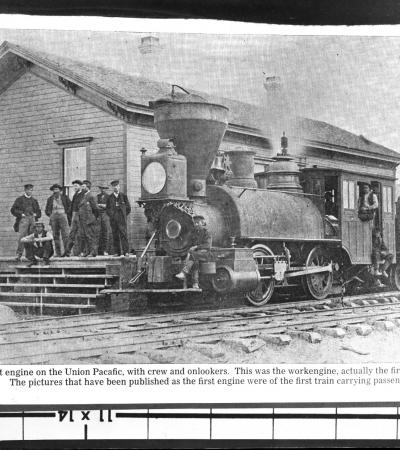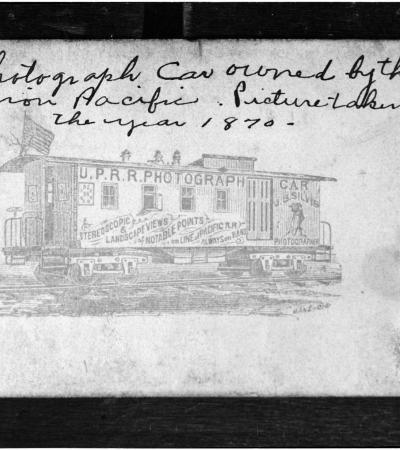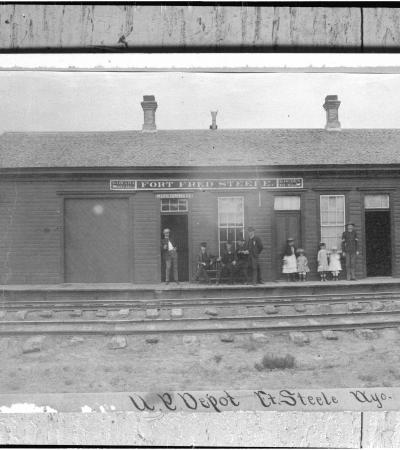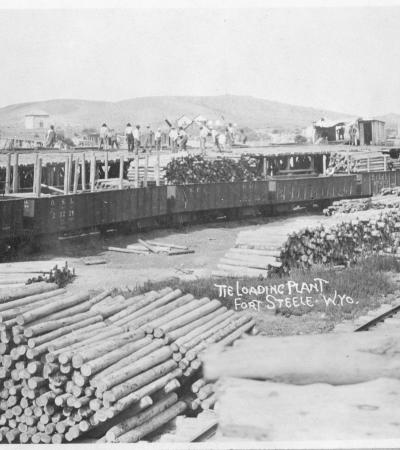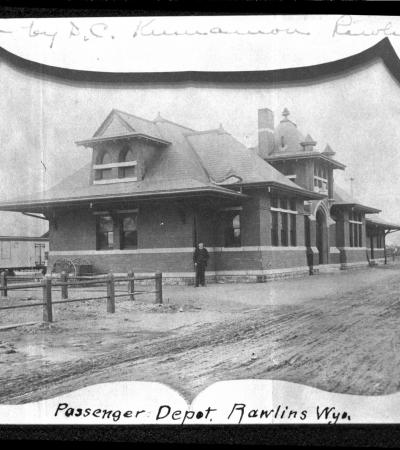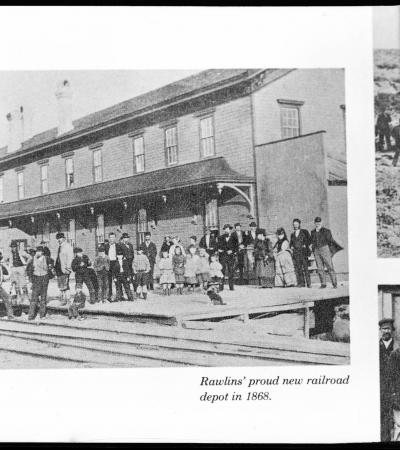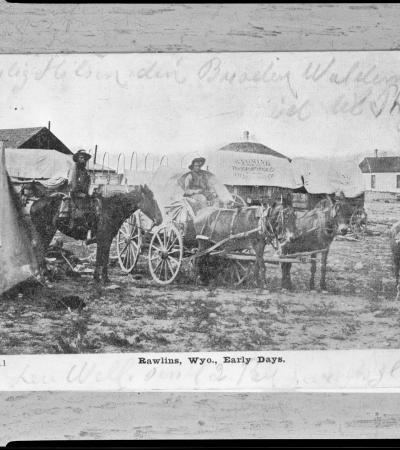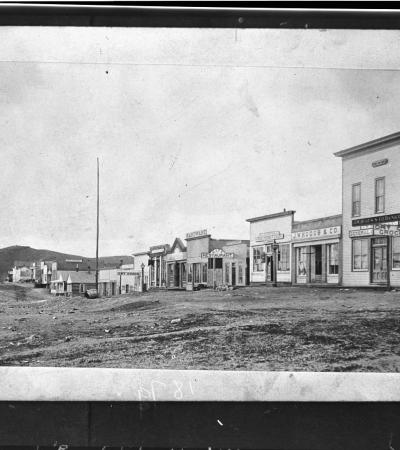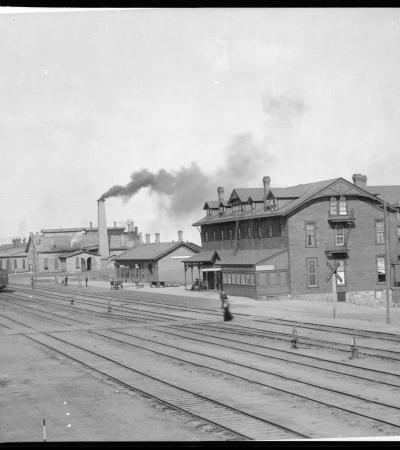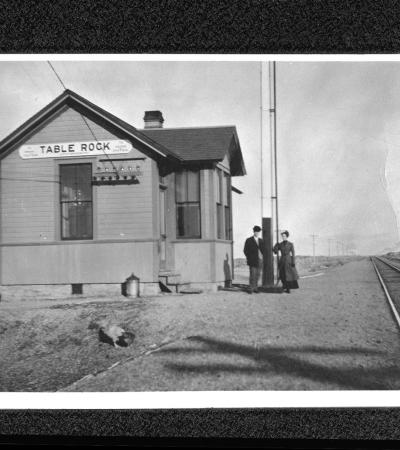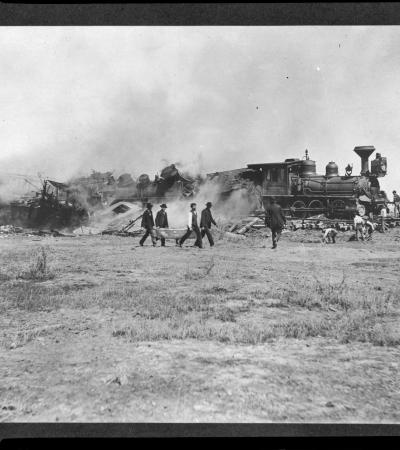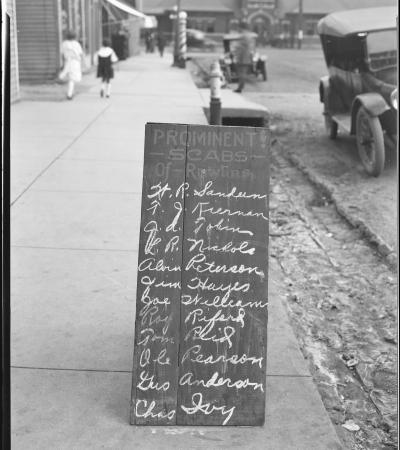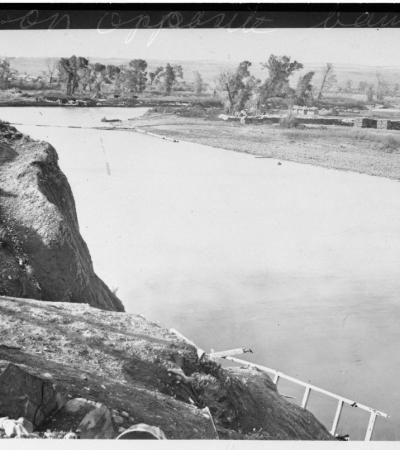Frank J. Meyers (1890-1973) was a photographer who lived in Rawlins, Wyoming, where he purchased the photography business of Hugh J. Rogner in 1923. Originally from Iowa, Rogner was employed at the Ferris Studio. Meyers ran the business for 50 years until his death.
Additional content for this collection can be found in the "Inventory for collection.”
Copy of photograph of the first Union Pacific locomotive to arrive in Cheyenne, Wyoming Territory, in 1867, which was a small work engine
Track-laying crews completed the Union Pacific Railroad line leading into Cheyenne on Nov. 13, 1867. The Union Pacific's chief engineer, Grenville Dodge, laid out the townsite and selected the location for locomotive shops. The following March, the UP board of directors selected the town as the location for a major depot and repair shops, ensuring Cheyenne's future as an important railroad town.
Copy of the imprint for the Union Pacific Railroad Photograph Car
The U.P.R.R. Photograph Car was not much more than a standard Union Pacific caboose fitted with living quarters, a darkroom, and a portrait studio illuminated by a skylight cut into the roof. The skylight also made it possible to print photographs during inclement weather. Elaborately painted on the exterior, signs on its sides declaring "STEREOSCOPIC & LANDSCAPE VIEWS of NOTABLE POINTS on LINE of PACIFIC R.R. ALWAYS on HAND." Trophy horns of elk and bighorn sheep, and sometimes the American flag, decorated the roof.
Copy of photograph captioned, "UP Depot, Ft Steele Wyo."
In 1868, when laborers were hard at work building the Union Pacific portion of the transcontinental railroad across what soon became southern Wyoming Territory, the U.S. government established three new outposts to protect work crews and new communities along the route. One of these was Fort Fred Steele, named for an officer of the Mexican and Civil wars and located where the new railroad crossed the North Platte River.
Copy of photograph captioned, "Tie Loading Plant Fort Steele Wyo."
The railroad also created supporting industries, including locomotive maintenance, steel manufacturing, coal mining, and logging for railroad ties.
Union Pacific Railroad depot in Rawlins, Wyoming Territory, 1868
Union Pacific chose Rawlins as part of its division points due to its location near a permanent water source and its semi-arid climate. The town became a transportation center for Northern Colorado and interior Wyoming. Stage lines ran northward to Lander and southward with daily service to Saratoga and Baggs. The White River line ran south to Meeker, Colorado.
Copy of photograph of Union Pacific Railroad depot in Rawlins, Wyoming Territory, 1868
Rawlins' Union Pacific Railroad depot is representative of how the railroad and its transportation connections contributed to the development and growth of the town. The railroad served as a reason for settlement and its transportation links provided support for the development of other industries and expansion of the city.
Copy of photograph captioned, "Rawlins, Wyo., Early Days"
Shown are wagons of the Wyoming Transportation Company, which was owned by J. W. Hugus. The construction of the UP railroad and establishment of Fort Steele on the railroad line brought more whites and settlers to the region. The fort trader’s store, J. W. Hugus and Company, was supplying ranchers and others by 1870.
Front Street, Rawlins, Wyoming Territory, 1879
Rawlins' Front Street at the intersection with Third Street as viewed from the grounds of the Union Pacific passenger depot. The first two buildings house J. W. Hugus & Co. The fourth building houses the UP Restaurant.
Union Pacific Railroad hotel, depot, and roundhouse in Rawlins, Wyoming Territory, ca. 1885
As in other towns, the Union Pacific operated in Rawlins not only as a train company, but also a hotel and an eatery.
Depot at Table Rock, Wyoming, ca. 1890.
Named after the flat rocks that surround the area, the town of Table Rock was established in the late 1800’s as a depot for the railroad and having only a population of six by 1880, one of which was the wife to a railroad worker. Table Rock is now a ghost town in present-day Sweetwater County.
Crash on Union Pacific Railroad, ca. 1890.
The railroad served its purpose of providing transportation, but it was neither well built nor safe. Workers died in boiler explosions, falls from moving trains and collisions. Some brakemen broke their necks on snow sheds with low clearance. The hastily built Union Pacific line needed to be rebuilt almost from the moment of its completion. Grenville Dodge later referred to the railroad he built as “two ballasted streaks of rust.”
List of "Prominent Scabs of Rawlins," July 1922
Worker strikes have been part of railroad history since the building of the transcontinental railroad. One of those strikes was the Railroad Shop Workers Strike that took place from July to Oct. 1922 and included some 400,000 strikers nationwide. The walkout was touched off when the U.S. Railroad Labor Board cut wages for railroad shop workers by 7 cents. Instead of negotiating, the railroad companies replaced three-quarters of the strikers with non-union workers. Strikers finally returned to work after settling for a 5 cent pay cut.
Railroad ties on North Platte River, ca. 1900
The Wyoming Timber Company would float railroad ties down the North Platte River past Saratoga to its loading plant at Fort Steele, on the Union Pacific.
